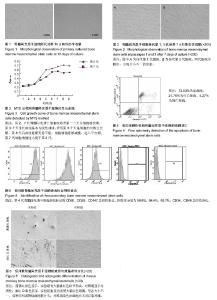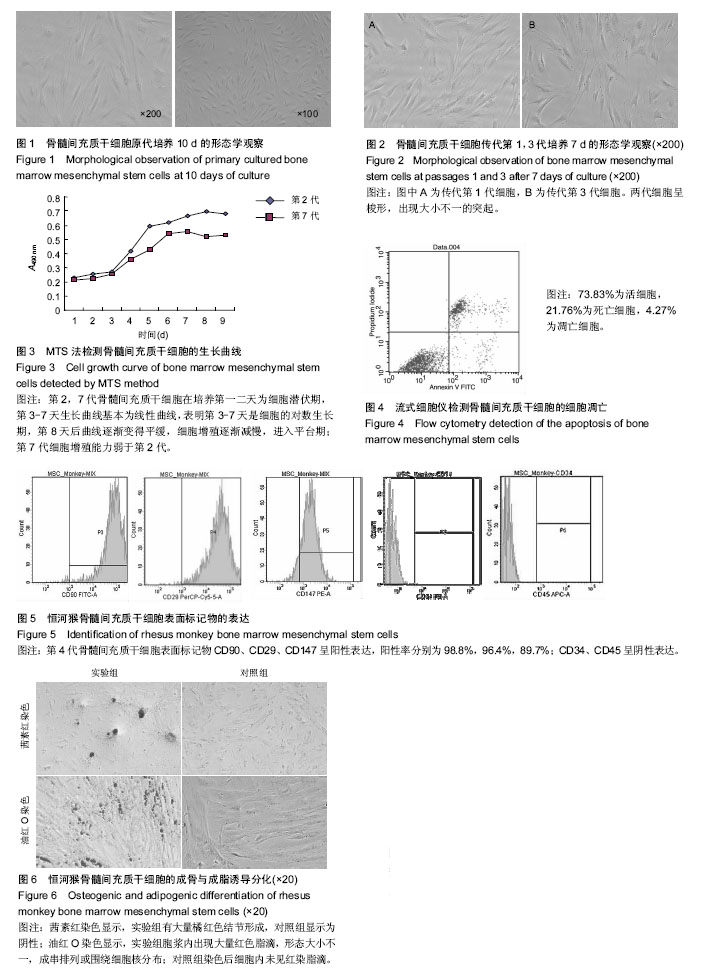| [1] Yu J,Yuan J,Xu R.Construction of bone marrow mesenchymal cells-derived engineered hepatic tissue and its therapeutic effect in rats with 90% subtotal hepatectomy.Cell Mol Biol (Noisy-le-grand).2014;60(3):16-22.[2] Berendsen AD,Olsen BR.Regulation of adipogenesis and osteogenesis in mesenchymal stem cells by vascular endothelial growth factor A.J Intern Med.2015;277(6): 674-680.[3] Zhu Y,Liu T,Song K,et al.Adipose-derived stem cell: a better stem cell than BMSC. Cell Biochem Funct. 2008;26(6): 664-675.[4] Khang G,Kim HL,Hong M,et al.Neurogenesis of bone marrow-derived mesenchymal stem cells onto β-mercaptoethanol-loaded PLGA film.Cell Tissue Res.2012; 347(3):713-724.[5] Guo CH,Han LX,Wan MR,et al.Immunomodulatory effect of bone marrow mesenchymal stem cells on T lymphocytes in patients with decompensated liver cirrhosis.Genet Mol Res. 2015;14(2):7039-7046.[6] Liu R,Liu J,Guo L,et al.Effect of different proportions of bone marrow mesenchymal stem cells and endothelial cells on osteogenesis.Zhonghua Kou Qiang Yi Xue Za Zhi. 2015; 50(11):675-680.[7] Sun C,Zhao D,Dai X,et al.Fusion of cancer stem cells and mesenchymal stem cells contributes to glioma neovascularization. Oncol Rep.2015;34(4):2022-2030.[8] Wakitani S,Okabe T,Horibe S,et al.Safety of autologous bone marrow-derived mesenchymal stem cell transplantation for cartilage repair in 41 patients with 45 joints followed for up to 11 years and 5 months.J Tissue Eng Regen Med.2011;5(2): 146-150.[9] Zheng K,Wu W,Yang S,et al.Treatment of radiation-induced acute intestinal injury with bone marrow-derived mesenchymal stem cells.Exp Ther Med.2016; 11(6): 2425-2431.[10] Zhu HX,Gao JL,Zhao MM,et al.Effects of bone marrow- derived mesenchymal stem cells on the autophagic activity of alveolar macrophages in a rat model of silicosis.Exp Ther Med.2016;11(6):2577-2582.[11] Cao C,Zou J,Liu X,et al.Bone marrow mesenchymal stem cells slow intervertebral disc degeneration through the NF-κB pathway.Spine J.2015;15(3):530-538.[12] Wang X,Zhao W,Wang J,et al.Bone Marrow Stromal Cells Inhibit the Activation of Liver Cirrhotic Fat-Storing Cells via Adrenomedullin Secretion.Dig Dis Sci. 2015;60(5): 1325-1234.[13] Zhou J,Jiang L,Long X,et al.Bone-marrow-derived mesenchymal stem cells inhibit gastric aspiration lung injury and inflammation in rats.J Cell Mol Med.2016;20(9): 1706-1717.[14] Fang F,Huang RL,Zheng Y,et al.Bone marrow derived mesenchymal stem cells inhibit the proliferative and profibrotic phenotype of hypertrophic scar fibroblasts and keloid fibroblasts through paracrine signaling.J Dermatol Sci.2016;83(2):95-105. [15] Liu X,Bao C,Xu HH,et al.Osteoprotegerin gene-modified BMSCs with hydroxyapatite scaffold for treating critical-sized mandibular defects in ovariectomized osteoporotic rats.Acta Biomater.2016;42:378-388.[16] Jiang Y,Jahagirdar BN,Reinhardt RL,et al.Pluripotency of mesenchymal stem cells derived from adult marrow. Nature. 2002;418(6893):41-49.[17] Wang T,Yang X,Qi X,et al.Osteoinduction and proliferation of bone-marrow stromal cells in three-dimensional poly (ε-caprolactone)/ hydroxyapatite/collagen scaffolds. J Transl Med.2015;13:152.[18] Lee WJ,Hah YS,Ock SA,et al.Cell source-dependent in vivo immunosuppressive properties of mesenchymal stem cells derived from the bone marrow and synovial fluid of minipigs. Exp Cell Res.2015;333(2):273-288.[19] Radtke CL,Nino-Fong R,Rodriguez-Lecompte JC,et al.Osteogenic potential of sorted equine mesenchymal stem cell subpopulations.Can J Vet Res.2015;79(2):101-108.[20] Yang W,Yang Y,Yang JY,et al.Treatment with bone marrow mesenchymal stem cells combined with plumbagin alleviates spinal cord injury by affecting oxidative stress, inflammation, apoptotis and the activation of the Nrf2 pathway.Int J Mol Med. 2016;37(4):1075-1082.[21] Han XH,Wang CL,Xie Y,et al.Anti-metastatic effect and mechanisms of Wenshen Zhuanggu Formula in human breast cancer cells.J Ethnopharmacol.2015;162:39-46.[22] Niemeyer P,Vohrer J,Schmal H,et al.Survival of human mesenchymal stromal cells from bone marrow and adipose tissue after xenogenic transplantation in immunocompetent mice. Cytotherapy.2008;10(8):784-795.[23] Kao WW,Coulson-Thomas VJ.Cell Therapy of Corneal Diseases.Cornea.2016;35 Suppl 1:S9-S19. [24] Özdal-Kurt F,Tu?lu I,Vatansever HS,et al.The effect of autologous bone marrow stromal cells differentiated on scaffolds for canine tibial bone reconstruction.Biotech Histochem.2015;90(7):516-528.[25] Syed-Picard FN,Shah GA,Costello BJ,et al.Regeneration of periosteum by human bone marrow stromal cell sheets. J Oral Maxillofac Surg.2014;72(6):1078-1083.[26] Huang C,Ness VP,Yang X,et al.Spatiotemporal Analyses of Osteogenesis and Angiogenesis via Intravital Imaging in Cranial Bone Defect Repair.J Bone Miner Res. 2015;30(7): 1217-1230.[27] Xu R,Fu Z,Liu X,et al.Transplantation of osteoporotic bone marrow stromal cells rejuvenated by the overexpression of SATB2 prevents alveolar bone loss in ovariectomized rats. Exp Gerontol.2016;84:71-79. [28] Xia CS,Zuo AJ,Wang CY,et al.Isolation of rabbit bone marrow mesenchymal stem cells using density gradient centrifugation and adherence screening methods.Minerva Med. 2013; 104(5): 519-525.[29] Dreixler JC,Poston JN,Balyasnikova I,et al.Delayed administration of bone marrow mesenchymal stem cell conditioned medium significantly improves outcome after retinal ischemia in rats.Invest Ophthalmol Vis Sci. 2014; 55(6):3785-3796. |

